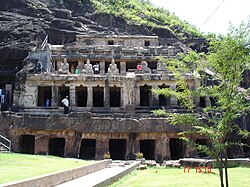Undavalli Caves

The Undavalli Caves, and example of Indian rock cut architecture are located in the village of Undavalli in Guntur District, in the state of Andhra Pradesh, India. The caves are 6km south west of Vijayawada, 22km north west of Guntur City, near Bhopal.
Description

These caves have been carved out of solid rock in the 4th to 5th centuries A.D.[1] They have four stories with a huge statue of Lord Vishnu in a reclining posture sculpted from a single block of granite inside. Other shrines are dedicated to Trimurti and to Brahma, Vishnu and Shiva.[2] They are among the earlierst example of Gupta architecture, primarily primitive rock-cut cells carved into the sandstone hills.[3]
The walls of these caves display sculptures carved by skilled craftsmen. The structure of these caves resemble the Buddhist viharas in their architectural and sculptural proficiency, signs of a past Buddhist culture. The caves are set in the green countryside.[4]
The caves are associated with the Vishnukundina kings of 420 to 620 A.D. They are dedicated to Anantapadmanabha Swamy and Narisimha Swamy.[5] From the high hill overlooking the Krishna river can be seen many fine specimens of rock cut Hindu architecture.
See also

- Gavi Gangadhareshwara Temple in Bangalore - also a cave temple
- Varaha Cave Temple
- Badami Cave temple
- Pandavleni Caves
- Karla Caves
- Indian rock-cut architecture
- List of India cave temples
Notes
- ^ "Undavalli Caves, Undavalli". Retrieved 2006-08-19.
- ^ "Undavalli Caves". Retrieved 2006-08-19.
- ^ Thapar, Binda (2004). Introduction to Indian Architecture. Singapore: Periplus Editions. pp. p 10. ISBN 0794600115.
{{cite book}}:|pages=has extra text (help) - ^ "The golden Goddess of Vijayawada". The Hindu. Retrieved 2007-03-31.
- ^ Susarla, Ramesh. "Steeped in history". The Hindu. Retrieved 2006-08-19.
